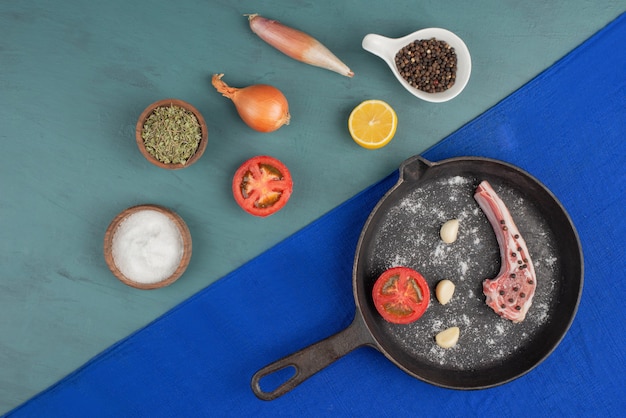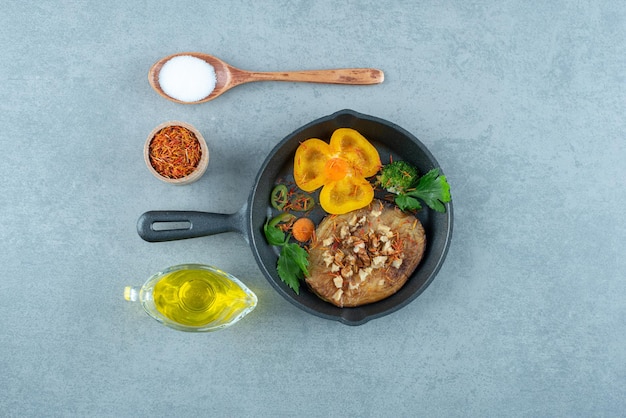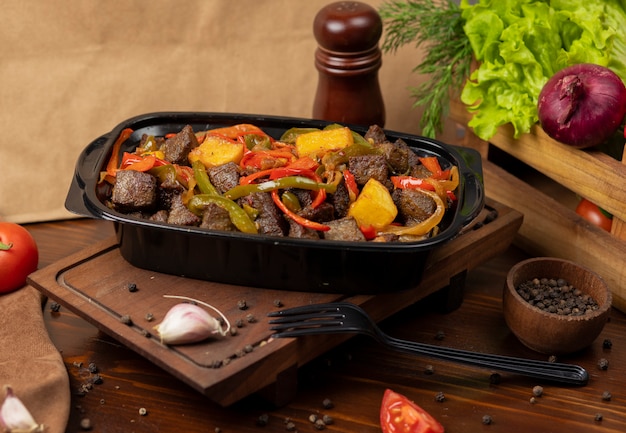Let's talk steak. But not just any steak – cast iron steak. There's a certain magic to the whole experience: the sizzling sound of a thick cut of beef hitting a blazing hot pan, the irresistible aroma that fills your kitchen, and the anticipation of that perfectly seared crust. Honestly, it's pure culinary bliss.
I've been a steak enthusiast for years, from those humble student days of budget-friendly meals to the more sophisticated dinners I enjoy now. And let me tell you, my love affair with cast iron cooking took my steak game to a whole new level.
This isn't just another article about cooking meat. This is your comprehensive guide to cast iron steak, packed with my personal experiences, tips, and tricks to help you achieve steak perfection. We'll cover everything from choosing the right cut to mastering the perfect sear. So, pour yourself a glass of something delicious, get comfy, and let's get this steak party started!
(Part 1) The Cast Iron Advantage

Why Cast Iron Reigns Supreme
You might be thinking, "Why all the fuss about cast iron? Can't I just use any old pan?" Well, I'm here to tell you, cast iron isn't just a pan, it's a culinary treasure. It's like that vintage leather jacket you cherish – rugged, durable, and imbued with character that develops over time. It's a trusty sidekick in the kitchen, always there for you, no matter what.
The Cast Iron Magic:
- Exceptional Heat Retention: Cast iron is a heat monster. It heats up evenly and holds onto that heat like a champ, creating a consistent and powerful sear across the entire steak. Think of it like a mini oven on your stovetop.
- Unbeatable Browning: The intense heat of cast iron is the secret to that gloriously crispy crust, the hallmark of a truly satisfying steak.
- Seasoning: A Natural Non-Stick: With proper care, your cast iron develops a natural, non-stick seasoning. It's like a protective layer, making cooking a breeze and preventing your steak from sticking to the pan.
- Versatility Beyond Compare: Cast iron isn't just for steaks! It's your all-purpose hero, from baking bread to frying up veggies.
(Part 2) Choosing the Perfect Cut

A Quick Guide to steak cuts:
Before we dive into the cooking, let's talk cuts. There's a whole world of steak cuts out there, and it can feel overwhelming at first. Here's a breakdown of some of the most popular options:
- Rib Eye: My personal favourite! It's the king of marbling, boasting incredible juiciness and flavour.
- new york strip: Leaner than its rib-eye cousin, but still packs a punch in terms of flavour.
- Sirloin: A classic choice, offering a nice balance of flavour and tenderness.
- filet mignon: This is the ultimate in tenderness, but it comes with a higher price tag.
Thickness is Key:
For cast iron searing, you want a steak that's at least 1-inch thick. Thicker cuts cook more evenly and hold their juices better, resulting in a juicy and flavourful centre.
My Go-To Choice:
For my cast iron steak, I usually go for a thick-cut rib eye. It's just so darn delicious! But don't feel limited to just one cut. Experiment with different cuts and find your personal favourite.
(Part 3) Preparing Your Steak for Searing Glory

Seasoning: The Foundation of Flavor
You're probably thinking, "Salt and pepper, right?" And you'd be right! But let's elevate our game a little.
I like to use good quality kosher salt, freshly ground black pepper, and a touch of garlic powder. But don't be afraid to get creative. Add paprika, onion powder, or a pinch of cayenne for a little kick. The key is to find a seasoning blend that suits your taste buds.
The Pat-Dry Trick:
Here's a tip I learned from a seasoned chef: pat your steak dry with paper towels before cooking. This simple step helps create a better sear and prevents steaming, which can make your steak soggy and less appealing.
Let it Rest:
Before you even think about putting your steak in the pan, let it come to room temperature for about 30 minutes. This ensures even cooking and helps prevent the steak from getting cold in the middle while the outside cooks.
(Part 4) Getting Your Cast Iron Ready for Action
The Importance of Heat:
This is where things get serious. You want your cast iron pan blazing hot before you even think about adding your steak.
I'm talking about that point where you see the smoke rising from the pan, the air sizzling around it. This is the magic temperature that produces that perfect sear.
Oil: Your Searing Ally:
Once your pan is screaming hot, add a generous amount of high-heat oil. I typically use grapeseed oil or avocado oil, but olive oil works well too. The key is to choose an oil that can handle the intense heat without breaking down.
The Bread Test:
Before you throw your steak into the pan, take a tiny piece of bread and drop it in. If it sizzles immediately and starts to brown quickly, you're good to go!
(Part 5) The Art of Searing Perfection
Time to Cook!
Finally, the moment of truth! Gently place your steak in the hot pan and let it sizzle. Resist the urge to touch it! Let it cook undisturbed for a few minutes, allowing a beautiful crust to develop on one side.
The Flip:
Don't rush the flip. Let the steak develop a good sear on one side before flipping it. You'll know it's ready when the bottom is nicely browned and a delicious crust has formed.
Cook to Your Preference:
This is where your personal preferences come into play. How you cook your steak is entirely up to you.
| Doneness | internal temperature | Time |
|---|---|---|
| Rare | 125-130°F (52-54°C) | 2-3 minutes per side |
| Medium-Rare | 130-135°F (54-57°C) | 3-4 minutes per side |
| Medium | 135-140°F (57-60°C) | 4-5 minutes per side |
| Medium-Well | 140-145°F (60-63°C) | 5-6 minutes per side |
| Well Done | 145-150°F (63-66°C) | 6-7 minutes per side |
You can use a meat thermometer to ensure your steak is cooked to your exact liking. But remember, it's all about personal taste.
(Part 6) The Importance of Resting
Let the Juices Redistribute:
Once your steak is cooked to perfection, take it off the heat and let it rest for at least 5-10 minutes. This allows the juices to redistribute throughout the steak, resulting in a more tender and flavorful experience.
The Magic of Resting:
You might be tempted to dig in immediately, but trust me, a little patience goes a long way. While your steak is resting, you can get those delicious sides ready!
(Part 7) Serving Up Steak Perfection
The Final Touches:
Your cast iron steak is ready to be enjoyed! Slice it against the grain for optimal tenderness and arrange it beautifully on a plate.
Sizzling Sides to Complement Your Steak:
To elevate your steak feast, I love to pair it with simple but delicious sides. Here are some of my go-to choices:
- Roasted Vegetables: roasted asparagus, Brussels sprouts, or broccoli are excellent companions to a juicy steak.
- Garlic mashed potatoes: Creamy, buttery, and utterly comforting, mashed potatoes are a perfect pairing.
- Green Salad: A refreshing counterpoint to the richness of the steak, a green salad adds a nice balance to the meal.
- grilled corn on the Cob: A classic barbecue favourite, grilled corn is a delicious and satisfying side.
Wine Pairing:
For the ultimate indulgence, pair your steak with a glass of red wine. Cabernet Sauvignon, Merlot, or Shiraz are all excellent choices, offering a delightful complement to the richness of the steak.
(Part 8) cast iron care and Maintenance:
The Secret to Seasoning:
Cast iron is like a demanding but rewarding friend. It needs a little TLC to keep it in top shape.
Proper seasoning is crucial. It creates a protective layer that prevents sticking and ensures your pan lasts for generations.
Here's how to season your cast iron:
- Wash the pan with hot water and a small amount of dish soap.
- Dry the pan thoroughly with a clean towel.
- Apply a thin layer of oil to the entire surface of the pan.
- Place the pan in a preheated oven at 350°F (175°C) for 1 hour.
- Turn off the oven and let the pan cool down completely inside the oven.
Repeat this process every few months, or whenever the seasoning starts to wear off.
Don't Fear the Rust:
Don't panic if you see some rust on your cast iron. It's easily remedied! Just use a wire brush or steel wool to scrub it off, re-season the pan, and you're good to go.
(Part 9) FAQs
1. Can I use a cast iron pan on a glass cooktop?
While cast iron is incredibly versatile, it's not recommended for use on glass cooktops. The rough surface of the cast iron can scratch the smooth glass, potentially damaging your cooktop.
2. Can I use soap to clean my cast iron?
A little bit of soap won't hurt, but it's best to avoid using soap too often. Soap can strip away the seasoning, so it's best to stick to hot water and a scrub brush for most cleaning.
3. How do I know when to replace my cast iron pan?
Cast iron pans are incredibly durable and can last for generations if properly cared for. However, if the pan becomes warped or cracked, it's time to replace it.
4. What are some tips for preventing sticking?
Make sure your pan is properly seasoned and hot before you add your food. Also, pat your food dry before cooking.
5. What are some good alternatives to cast iron?
If you're not ready to commit to the world of cast iron, there are some other great options available. A good quality stainless steel pan is a good choice, and you can also look into carbon steel pans.
And there you have it! My ultimate guide to cast iron steak. I hope you found it helpful and inspiring. Now, go forth and get sizzling!
Everyone is watching

How to Cook Frozen Lobster Tails Perfectly: A Step-by-Step Guide
RecipesLobster. Just the word conjures up images of lavish meals, special occasions, and a taste of luxury. But let's...

Pigs in a Blanket Cooking Time: How Long to Bake for Perfect Results
RecipesAh, pigs in a blanket. Just the name conjures up images of those delightful little parcels of crispy pastry en...

Pork Fillet Cooking Time: How Long to Cook It Perfectly
RecipesPork fillet, or tenderloin as it's sometimes called, is a real favourite in our house. It's so versatile, and...

The Ultimate Guide to Cooking Delicious Frankfurters
RecipesLet's face it, we all love a good frankfurter. It's a classic, simple, and always satisfying. But let's be rea...

Wolf Meat Recipes: A Guide to Cooking Wild Game
RecipesLet's be honest, you don't see wolf meat at your local butcher shop every day. It's a bit of a wild card, but ...
